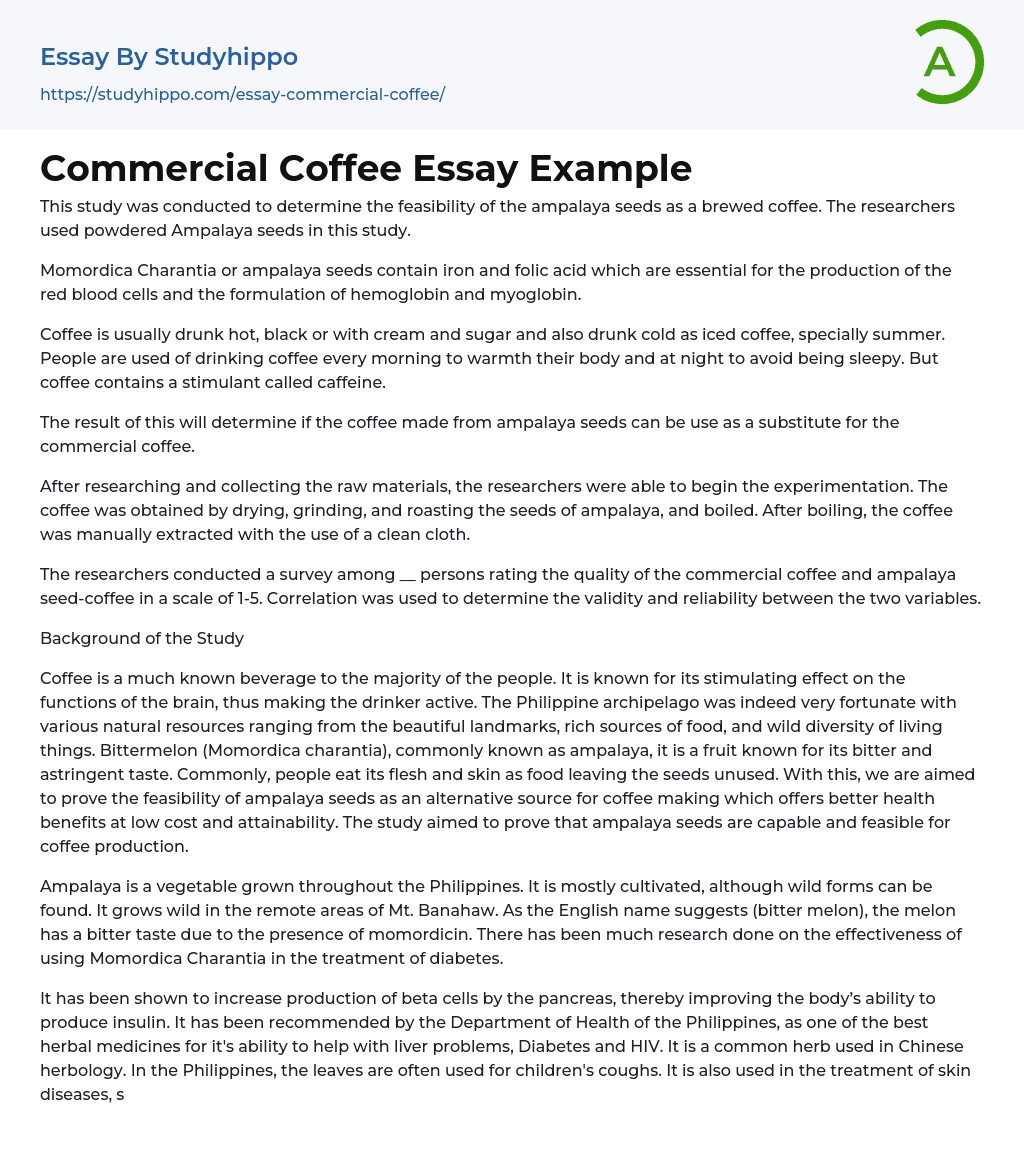In a study, researchers tested the feasibility of using powdered ampalaya seeds as a brewed coffee.
Momordica Charantia, commonly referred to as ampalaya, is rich in iron and folic acid. These two nutrients are essential for the synthesis of red blood cells and the development of hemoglobin and myoglobin.
Coffee is typically consumed hot, either plain or with cream and sugar. However, it can also be enjoyed cold, like iced coffee, especially in warmer seasons. Many people drink coffee in the morning to energize their body, while having it in the evening prevents drowsiness. It's important to note that coffee contains caffeine, which is a stimulant.
The purpose of this experiment is to evaluate if coffee made from ampalaya seeds can be a suitable substitute for commercially sold coffee.
After gathering the necessary materials and conducting research, the researchers began
...their experimentation process. They prepare the coffee by drying, grinding, and roasting ampalaya seeds before boiling it. The final step is manually extracting the coffee using a clean cloth.
The researchers conducted a survey among a certain number of individuals, wherein they rated the quality of commercial coffee and ampalaya seed-coffee on a scale of 1-5. They used correlation to establish the validity and reliability between these two variables.
The purpose of this study is to demonstrate the feasibility and benefits of using ampalaya seeds instead of coffee. Coffee is well-known for its ability to enhance brain function and increase energy levels. In addition to being a country with abundant natural resources and breathtaking landmarks, the Philippines also has bitter melon or ampalaya, which has a distinct bitter taste. While the fruit's flesh and skin are commonly consumed as
food, the seeds often go unused. This research aims to illustrate how incorporating these ampalaya seeds as an alternative ingredient in coffee production can provide superior health benefits at a lower cost and increased availability. Ultimately, this study seeks to validate that ampalaya seeds are indeed viable and practical for use in producing coffee.
Ampalaya, also known as bitter melon, is a vegetable that is cultivated throughout the Philippines. While it is primarily cultivated, wild forms can still be found, particularly in the remote areas of Mt. Banahaw. The melon gets its English name from its bitter taste, which is caused by the momordicin it contains. Numerous studies have been conducted to explore the potential of using Momordica Charantia in diabetes treatment.
According to research, this herb has the potential to enhance insulin production by the pancreas, thereby improving the body's capability to produce insulin. The Department of Health in the Philippines recommends this herb as an effective herbal medicine for liver problems, Diabetes, and HIV. It is widely utilized in Chinese herbology. In the Philippines, the leaves of this herb are commonly employed for treating children's coughs. Moreover, it is used to address skin diseases, female sterility, as a parasiticide, antipyretic, and purgative.
The objective of this research is to produce coffee using ampalaya seeds and evaluate its aroma, flavor, and level of acceptance in comparison with commercial coffee (specifically Nescafe Classic). The coffee samples are prepared using traditional methods of roasting, grinding, and brewing. A small group of assessors is assigned to judge the characteristics and acceptability of the samples. Each assessor receives a score sheet for evaluating the samples. The experiment was conducted at the
researcher's residence during the academic year 2013-2014.
Although commercial coffee lacks nutritional value, this study does not aim to compare the nutritional content of ampalaya seed coffee and commercial coffee or determine which one is more nutritious.
Methodology
To create ampalaya coffee, we followed the same process used for other types of coffee. We toasted and ground the seeds until they became soluble in water. The number of seeds dried, peeled, and toasted was [number of seeds]. The initial weight of the seeds before toasting was [initial weight]g, and after toasting to a golden brown color, they weighed [final weight]g. There was a difference of [weight difference]g before and after toasting the seeds. The pulverized seeds yielded a sample that is sufficient for [number of cups] cups of coffee.
After dissolving the ampalaya coffee sample in hot water, it behaved like a typical cup of coffee. This coffee had a bitter taste, which is expected for caffeine-free coffee. Therefore, the feasibility of using ampalaya seeds for coffee production is confirmed. Based on the results, it can be concluded that ampalaya seeds serve as an effective alternative to other coffee sources.
- Type 2 Diabetes essays
- Anatomy and Physiology essays
- Addiction essays
- Biodegradation essays
- Dental Care essays
- Disease essays
- Disorders essays
- Health Care essays
- Intelligence Quotient essays
- Nutrition essays
- Olfaction essays
- Public Health essays
- Women's Health essays
- World health organization essays
- Cancer essays
- Infectious Disease essays
- Lung Cancer essays
- Neurology essays
- Physical Exercise essays
- Medicine essays
- Sex essays
- Inquiry essays
- Disability essays
- Poison essays
- Action Potential essays
- Nervous System essays
- Childbirth essays
- Puberty essays
- Blood essays
- Kidney essays
- Neuron essays
- Body essays
- Glucose essays
- Sense essays
- Heart essays
- Skeleton essays
- Human Physiology essays
- Eye essays
- Immune System essays
- Muscle essays
- Skin essays
- Brain essays
- Central Nervous System essays
- Human Skin Color essays
- Digestive System essays
- Common sense essays
- Respiration essays
- alcoholism essays
- Smoking essays
- Casino essays




